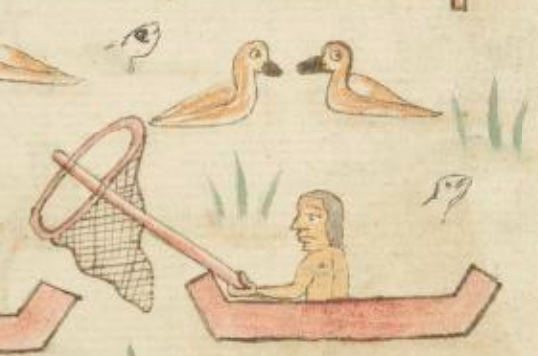tlatlama (Azca19)
This painted black-line drawing of the iconographic scene of a man fishing in a flat-bottomed boat is included here as an illustration of the verb, tlatlama (in this case, to fish). The man appears in a profile view, his skin painted tan or flesh-toned, his hair shoulder length. He holds a red pole at an angle. At the distant end of the pole is a red circle, and attached to this is a mesh net. The net has no fish in it, but the contextualizing image shows the head of a fish poking out of the water behind the person fishing. The boat appears to be a flat-bottomed, rectangular canoe that is painted red.
Stephanie Wood
See below for glyphs of similar boats (acalli) and nets (matlatl). The appearance of birds in the contextualizing image may suggest that the net might be used for catching birds, too.
Stephanie Wood
post-1550, possibly from the early seventeenth century.
Jeff Haskett-Wood
redes para pescar, pájaros, cazar, lanchas, canoas
tlatlama, to hunt, fish, or take captives, https://nahuatl.wired-humanities.org/content/tlatlama
Pescar
Stephanie Wood
The Codex Azcatitlan is also known as the Histoire mexicaine, [Manuscrit] Mexicain 59–64. It is housed in the Bibliothèque Nationale de France, and hosted on line by the World Digital Library and the Library of Congress, which is “unaware of any copyright or other restrictions in the World Digital Library Collection.”
https://www.loc.gov/resource/gdcwdl.wdl_15280/?sp=19&st=image
The Library of Congress is “unaware of any copyright or other restrictions in the World Digital Library Collection.” But please cite Bibliothèque Nationale de France and this Visual Lexicon of Aztec Hieroglyphs.




